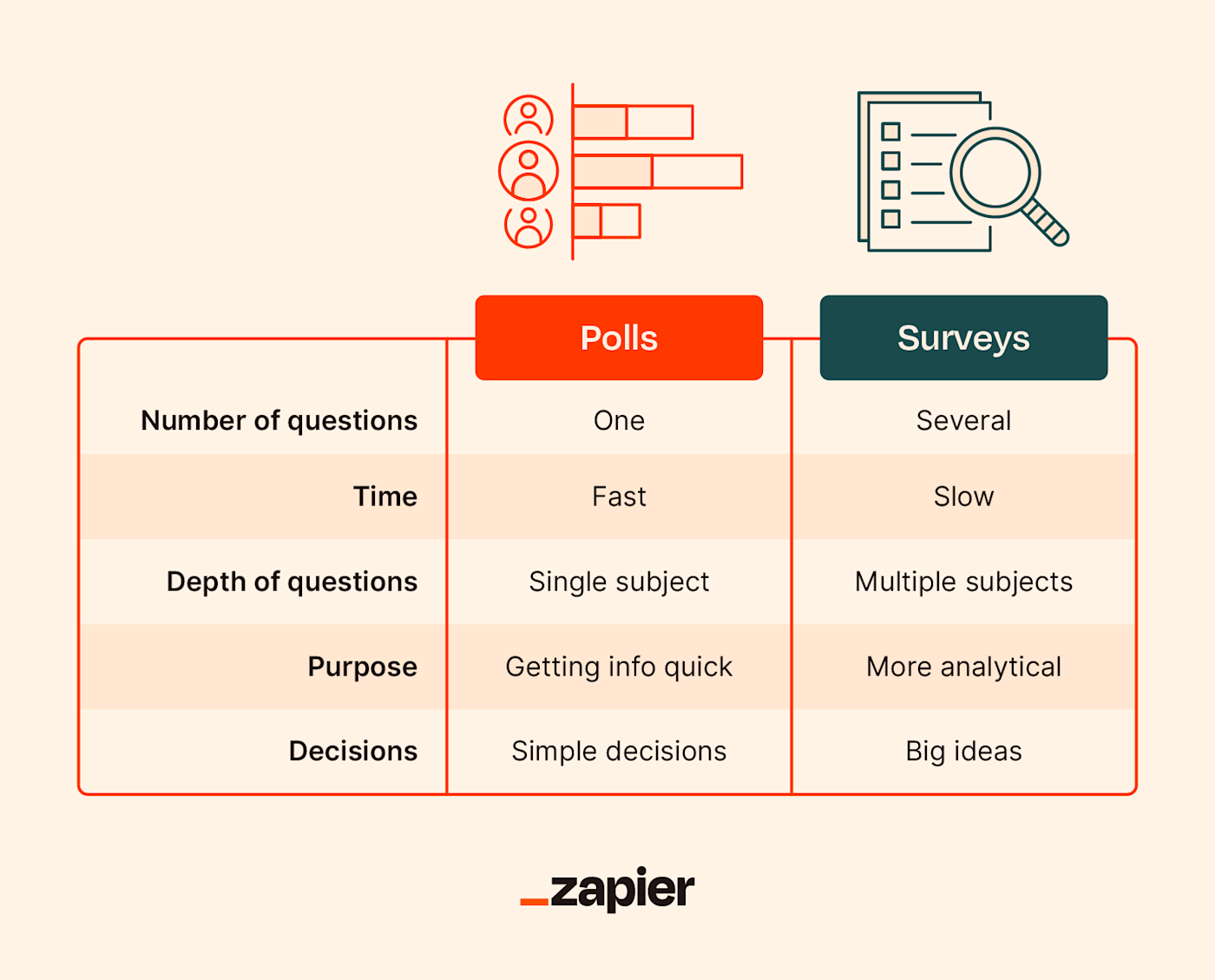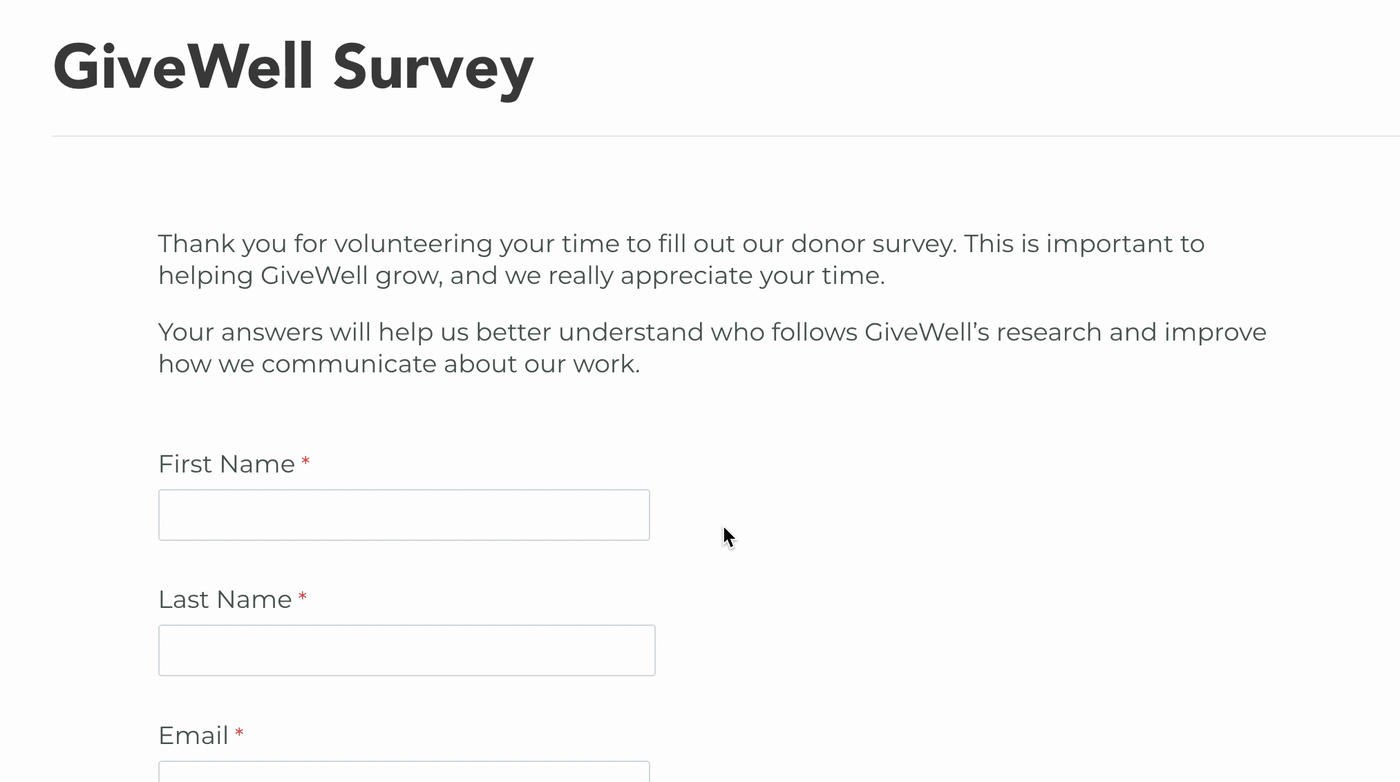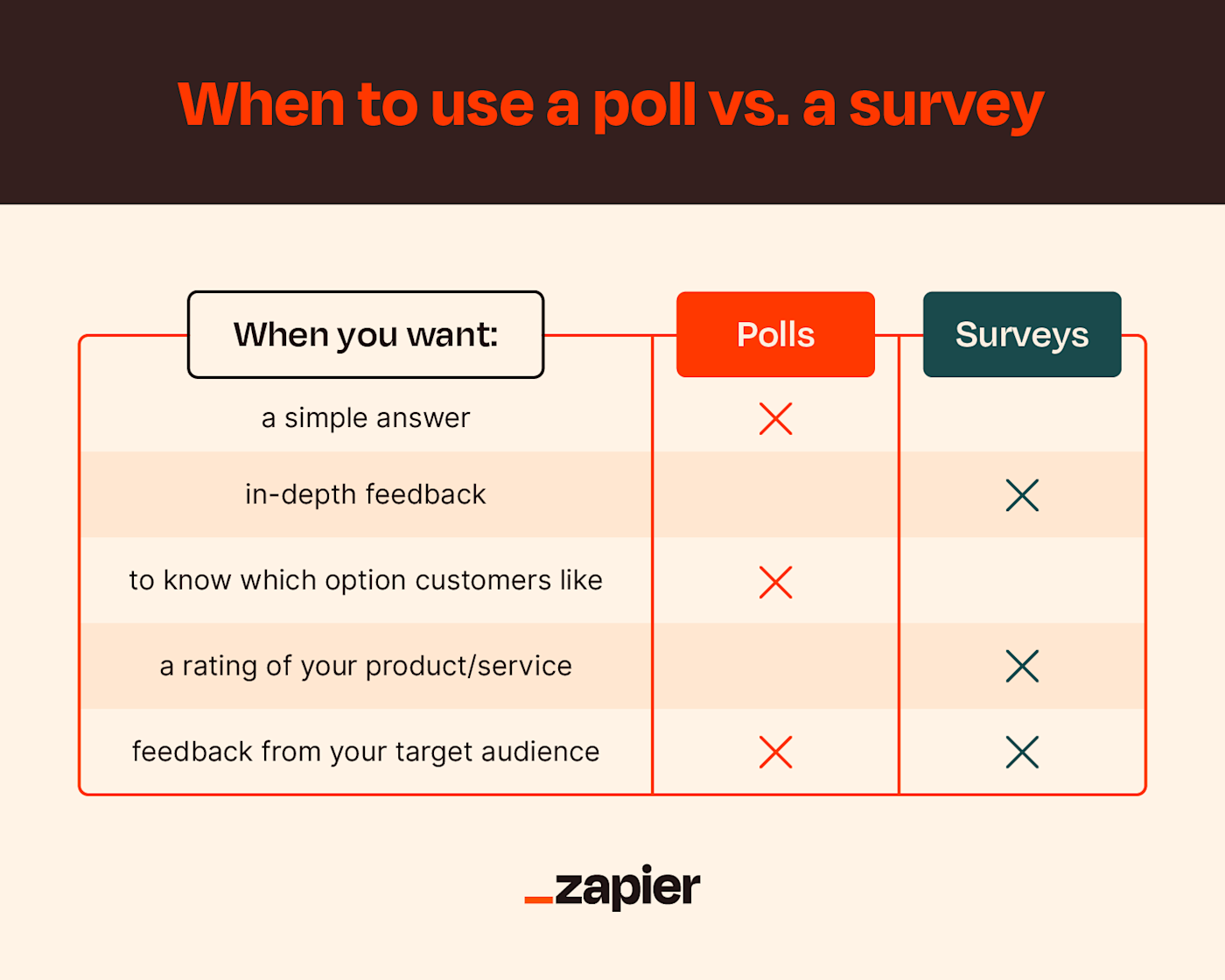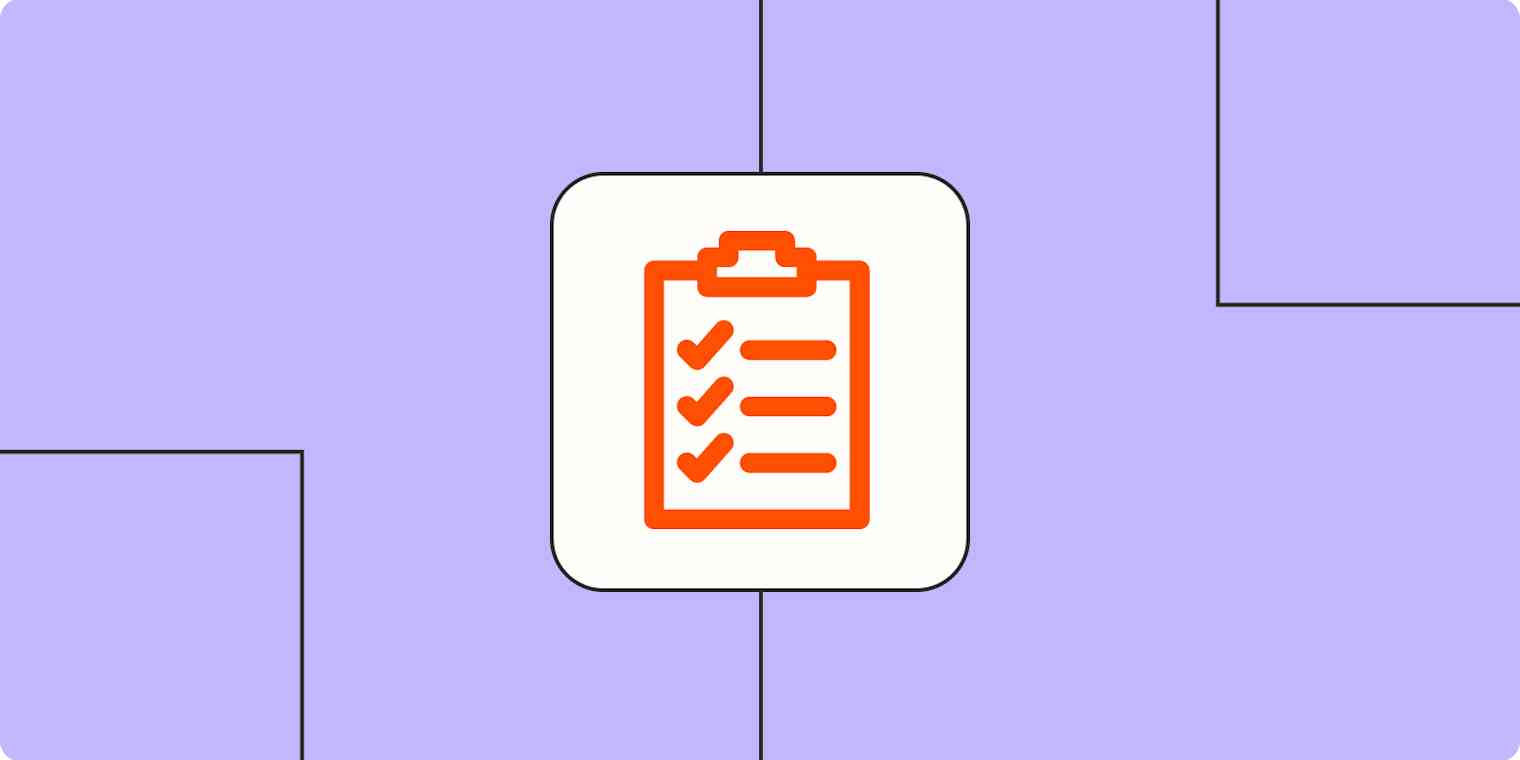You could spend all the money in the world on marketing and still wouldn't be able to do one thing: read your audience's mind. Polls and surveys are a gold mine for learning what your audience wants and gaining other valuable information.
But there are clear differences between polls and surveys. If you understand those differences and learn how to structure them, you'll be well on your way to understanding your audience.
Table of contents:
The difference between a poll and a survey
The difference between polls and surveys mostly comes down to length: a poll focuses on one question, and a survey asks multiple questions. But of course, there's a bit more nuance to it than that.

What is a poll?
A poll is a simple tool: you ask a single question to get your target audience's opinion. Polls are for quick yes or no answers or for giving people a choice between two or three options. You'll recognize polls from social media apps like Instagram and X (Twitter), where polls are baked into the functionality.
Polls can be a great way to have fun with your marketing. For example, if I were brave enough to let my audience decide how I should do my hair, I could run a poll that asks, "What should I do to my hair?" Then, I'd give them a few options like:
Dye it
Cut it short
Shave it off
Leave it the same
Don't care
For more serious purposes, polls should be used if you want a specific answer to a question. As an example: if you're trying to develop a strategy around a promotion and want to ask your website visitors which products they're most interested in, a poll would work great.
Types of polls
Polls gather instant insights, whether you're engaging your audience on social media or making crucial business decisions based on a sample's preferences. Here's a closer look at the different types of polls you can use:
Multiple-choice polls: These are the bread and butter of the poll world. Pose a question, and give participants multiple options to choose from. This is especially helpful when you have specific choices in mind and want to gauge which one stands out the most.
Ranking polls: Dive a layer deeper by asking participants to rank options in order of preference. This is especially useful when determining the hierarchy of preferences, say, for product features or event agendas.
Rating polls: Sometimes, it's all about the score. Here, participants rate an item or concept on a scale, typically ranging from 1-5 or 1-10. They're ideal for getting a temperature check on how well a concept or product is resonating.
Numeric polls: Numbers have a story to tell. Instead of giving participants pre-set options, you let them type in a numerical value. These polls are great for gauging estimates, like predicting sales or understanding quantities.
Text polls: Let the audience use their words. Participants are free to type a short text-based response. This comes in handy when you're fishing for fresh ideas or feedback that doesn't fit into a multiple-choice mold.
Remember, the beauty of polls lies in their simplicity and directness. However, like surveys, they're versatile. Don't hesitate to blend different types or adapt them to the unique needs of your audience and objectives.
What is a survey?
A survey is a series of questions (or sometimes just one question) that helps you gather more nuanced answers. It gives you more data to analyze and can provide you with deeper insights than a poll.
Instead of knowing if people liked something, you can find out how much they liked it.
You're able to include a series of short answer questions, which can help you get in-depth information you wouldn't have known to ask about.
You can ask a series of questions to help get more nuanced feedback on a topic.
You can use branching and logic to customize the survey experience.
Types of surveys
Surveys are a great way to get data from your coworkers and employees. You can also use them to gain valuable information from current and prospective customers. Here are some examples:
Employee experience surveys: Understand how new hires feel about the onboarding and training process, learn what employees think of management, find out what employees would like to see for incentive programs—you name it.
Net Promoter Score (NPS): The goal of NPS surveys is to figure out how likely people are to recommend you to others. This survey asks, "On a scale of 1 to 10, how likely are you to recommend us?" with one follow-up question.
Customer Effort Score (CES): This survey helps you understand if your customers have a hard time with your product or service and has questions like "On a scale from 1 to 10, how easy was it to use our product?"
Customer Satisfaction Score (CSAT): This is similar to a CES survey but about satisfaction instead of effort.
Market research surveys: A market research survey is a questionnaire designed to collect key information about a company's target market and audience that will help guide business decisions about products and services, branding angles, and advertising campaigns.
Of course, these are just standard survey styles—there are no real restrictions to the type of survey you do. You may want to try combining these types if you're looking to gather a lot of information and one style doesn't fit the purpose of your survey.
Forms vs. surveys
The difference between surveys and forms is a little subtler. In the simplest sense, forms collect specific data, while surveys are more suited for collecting nuanced feedback or opinions. For example, you'd use a form to collect purchase orders, event registrations, and email subscribers.
To better understand the difference, take a look at Zapier's list of the best form-building apps, which is different from their list of the best survey apps—though there is some overlap because many tools can absolutely do both.
Examples of polls and surveys
To give you a visual sense of what makes a poll and a survey different, take a look at an example of a poll from Zapier (through X) and an example of a survey from GiveWell.
Poll example: Is it too early for PSLs?
In honor of @Starbucks dropping their Fall drink menu tomorrow, we have a question...
— Zapier (@zapier) August 29, 2022
Is it too early for PSL (pumpkin spice latte)? 🎃☕️
This poll covering the controversial nature of the Pumpkin Spice Latte release provides a classic example of what a standard social media poll entails. Here's a closer look at its features:
Close-ended: No essay needed. No room for "Well, on a cool August morning when the wind blows from the east..." Just a simple, straight-up, close-ended question: "Too early for PSLs?" Perfect for our short attention spans and indecisive coffee habits.
One question: It's like speed-dating for polls. Zapier gets right to the heart of the matter. No beating around the bush, no fluff—just one pressing, caffeinated question.
Limited options: That's all you get. "Absolutely," "It's never too early," or "Show me the results." Clear, concise, and compelling enough to get you to click. Not too overwhelming, not too sparse. Like the Goldilocks of polls.
Clear deadline: The poll has a deadline. "Final results" drives home the fact that this isn't an eternal debate. It's a snapshot of the public's caffeine cravings at a particular moment in time.
Timeliness: It capitalizes on Starbucks's recent announcement. It's topical. It's relevant. And let's be honest—we all have an opinion on PSLs, whether we'd like to admit it or not.
Survey example: Volunteer experience

GiveWell has taken a distinct approach to gathering feedback on donors' experiences. By understanding its contributors better, it aims to foster stronger connections and refine its outreach efforts. Here's what its survey is doing well:
Balancing quantity with quality: While it begins with more quantitative questions, like, "How many hours did you spend this year choosing which organization(s) you would give to?" they transition into qualitative inquiries that dive into the donor's sentiments and preferences.
Financial commitments: GiveWell doesn't shy away from delving into the specifics. It's looking to understand the monetary contributions of current and past donors. Questions like, "How much do you expect to give to charity this year, total?" and "How much did you give to charity last year, total?" paint a picture of a donor's financial trajectory.
Loyalty checkpoint: "What percentage of your charitable giving goes to GiveWell or our recommended charities?" Ah, the loyalty litmus test. A window into trust, this question serves as a silent testament to the bond between GiveWell and its donors.
Feedback points: Direct, open-ended questions such as, "What do you like best about GiveWell?" and "What would you most like to change about GiveWell?" provide a clear channel for praise and constructive criticism. This shows GiveWell values its community's opinions and wants to grow from their feedback.
When to use a poll vs. a survey
Polls and surveys are both excellent ways to get feedback from your target audience. But generally, polls are best when you're looking for a simple answer or to find out which of a few options your customers prefer. Surveys, on the other hand, are best for in-depth feedback or to get a rating for your product or service.
When deciding between a poll and a survey, also consider:
Customer time: Polls should be about as long as an elevator pitch. If your inquiry is going to take any longer than it takes to get to the break room, consider putting together a survey.
The number of questions: A poll is a one-question wonder, perfect for quick opinions. Surveys, on the other hand, are the conversation starters designed for those multi-question dialogues.
The purpose: If you're after a simple pulse check or preference, a poll will do the trick. But if you're aiming to understand the broader "why" and "how," then it's survey time.

Polls and surveys: How to run them effectively
Whether you're running a poll or survey, you're looking to accomplish one thing: read your audience's mind. And to do that, you'll need clarity, precision, and a well-defined audience. In both polls and surveys, make sure your questions are direct, easy to understand, and genuinely relevant to the respondents.
A well-timed question can yield gold, but a misstep can lead to skewed data or, worse, disinterested participants. Engage your audience by being transparent about the purpose and ensure every question has a clear intent. After all, in this game, it's about quality, not quantity.
The rise of survey and poll apps equipped with generative AI has made crafting compelling questions simpler. Such tools not only assist in formulating questions, but adapt based on real-time user responses, ensuring a more personalized and effective data collection experience. Investing in these advanced tools could be the edge you need in today's fast-paced, data-driven world.
How to run an effective poll
The main problem with polls is that they aren't all that nuanced. But that doesn't mean you can't get the information you need from them. Here are some tips:
Only ask close-ended questions: Close-ended questions give you quantitative data, and open-ended questions create a mess when you're doing a poll—save those for surveys.
Open-ended: What did you like about this product?
Closed-ended: Did you like this product?
Keep poll questions short and simple: A poll question should be one sentence. If necessary, add an intro sentence for some context to the question you're asking.
Limit options: Your poll should ideally have two or three options, but you can stretch it to five. If you want to get more detail than that, it may be time to use a survey.
Have a "don't know"/"does not apply" option: Some polls warrant a simple yes or no, but you should also have a "not applicable" option or something similar. If you don't have that option, you may be forcing an answer. For example, if you ask, "Do you like apples or oranges better?" you may want the options to reflect more than just one or the other—it'd be valuable to know if people simply don't like fruit.
Only ask one question: For the love of all things good in this world, your one question needs to be one question. It's tempting to cram multiple questions into one question, like "Did you enjoy the product and customer service?" But what if the product was great but the customer service was awful, or vice versa? Split these into multiple questions, and create a survey if you need that much information.

Once you have your question and answer options built out, you just need to get the poll out into the world. If you don't want to run your poll on social media, there are plenty of online poll apps to choose from.
How to run a quality survey
The main issue with surveys is that they're time-consuming for both you and the people filling them out. You really need people who care about your efforts in order for them to actually want to sit down and take the time to complete your survey. Here are some tips to help:
Rely on loyal customers: The sky's the limit when adding survey questions, but you need an extremely loyal customer base if you make it lengthy, or they're not going to complete it. The great thing is that loyal customers are happy to do surveys because it makes them feel part of the process.
Don't forget about prospects: Loyal customers are a great segment to focus on, but you also want feedback from people who are new or even unfamiliar with your brand. This group often contains people who have awareness but haven't purchased yet.
Tell respondents what to expect: Nobody likes starting a survey and then realizing it's going to take a lot longer than they were planning. Being transparent about how long it will take will not only increase the likelihood of them finishing the survey, but will also make them more likely to do your next one.
Use the right question types: Most surveys will include a variety of question types, including yes/no, multiple choice, dropdown, ranking, short answer, and more. Be sure you're using the right question type for the right question, and consult best practices for developing an effective survey.
Lean on your survey app for help: The best survey apps will have sample questions for you to use based on the type of survey you're creating, and many will even have entire survey templates. Lots of research has been put into creating these, so don't feel like you have to reinvent the wheel every time.
Always have a short-answer section: Each survey should have a short-answer section. This gives respondents the ability to give you answers to questions that you may not have asked as additional feedback. You don't know what you don't know, and unlike with polls, you can find out. Even if it's the last question on the survey, let people add anything you might have missed.
Use branching and logic: Create "if-then" functions within your survey. For example, if the person answers "yes" to this question, then they receive option 1 as the next question, or if they answer "no," then they receive option 2. You wouldn't want a person to answer "No, I've never used this product," and then continue answering questions about it.
Survey a representative sample: If you can't create a representative sample of your target audience of customers or prospective customers, you need to include additional questions. For example, include demographic questions in your survey so you can categorize the data once the survey is complete.
Automate your polls and surveys
Once you set up your poll or survey, you can use automation to feed responses directly into a platform of your choosing, so you can easily comb through it without having to organize it yourself. Automatically send responses to your CRM, database, spreadsheet, or wherever else you store things. Learn more about how to automate your forms and surveys.
Related reading:
This article was originally published in June 2015. The most recent update, with contributions from Michael Kern, was in September 2023.





